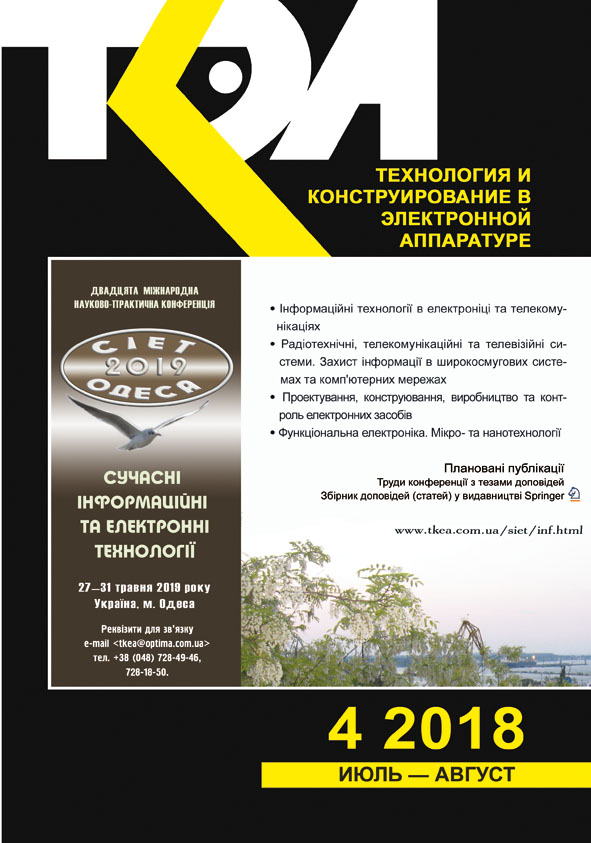Controlling voltage drops in silicon diodes by electron irradiation and thermal treatment
Abstract
High-frequency limiting rectifier diodes are used in power sources for rectifying alternating current, in protective elements of radio-electronic equipment, and in switching devices. They are the basis of energy-saving devices, meeting the high requirements for power limit and performance. The main task in the manufacturing process of high-frequency diodes is to ensure the low leakage current and the optimum value of the forward voltage drop which can be compared with the contact potential difference of the p–n junction.
This paper is devoted to studying the effect of radiation exposure and subsequent heat treatment on the current-voltage and capacitance characteristics of high-frequency silicon diodes. The authors studied p+–p–n–n+ diodes made of n-type KEF-4 (КЭФ-4) silicon wafers with an initial thickness of 235 μm. Radiation processing was performed using an ELU-6 (ЭЛУ-6) linear electron accelerator. The integral flux of "fast" electrons ranged from 1,0·1015 to 2,6·1017 cm–2, energy was 1.5 MeV, density was 1,7·1011 — 5,5·1013 cm–2·s–1. Heat treatment was performed for 5 hours at a temperature of 90°C in a special chamber.
The studies have shown that heat treatment lead to a shift of the forward current-voltage characteristic to a region of lower voltages (i.e., a given current can be reached at a lower voltage); at low current values, however, the voltage drop may increase after heat treatment. Reverse current decreased fivefold, resulting in a decrease in power output. At the same time, the temporal characteristics of the diode could also be improved by reducing the capacitance (to one order of magnitude).
References
Sinitsa A.V., Glukhov A.V., Skornyakov S.P., Karimov A.V., Rakhmatov A.Z. [Some features of designing powerful rectifier-limiting diodes for network protection devices]. Power electronics, 2015, no. 3, pp. 54–56. (Rus)
Hazdra P., Vobecky J., Dorschner H., Brand K. Axial lifetime control in silicon power diodes by irradiation with protons, alphas, low- and high-energy electrons. Microelectronics Journal, 2004, vol. 35, no. 3, pp. 249–257. https://doi.org/10.1016/S0026-2692(03)00194-0
Kozlov V. A., Kozlovski V. V. Doping of semiconductors using radiation defects produced by irradiation with protons and alpha particles. Semiconductors, 2001, vol. 35, iss. 7, pp. 735–761. https://doi.org/10.1134/1.1385708.
Vobecky J., Hazdra P., Zahlava V. Impact of the electron, proton and helium irradiation on the forward I–V characteristics of high-power P–i–N diode. Microelectronics Reliability, 2003, vol. 43, no. 4, pp. 537–544. https://doi. org/10.1016/S0026-2714(03)00023-4
Lagov P.B., Drenin A.S. Development of radiation technology for precision control of switching characteristics of silicon power devices. Proceedings of the International Scientific and Technical Leonardo da Vinci Conference. Wissenschaftliche Welt, 2013, vol. 1, pp. 130–132. (Rus)
Rakhmatov A. Z., Petrov D.A., Karimov A.V. et al. Influence of neutron radiation on breakdown voltage of silicon voltage limiter. Radioelectronics and Communication Systems, 2012, vol. 55, iss. 7, pp. 332–334. https://doi.org/10.3103/S0735272712070060
Poklonski N. A., Gorbachuk N. I., Tarasik M. I. et al. Effects of fluences of irradiation with 107 MeV krypton ions on the recovery charge of silicon p+-n-diodes. Acta Physica Polonica A, 2011, vol. 120, no. 1, pp. 111–114. https://doi.org/10.12693/APhysPolA.120.111
Rakhmatov A.Z., Karimov A.V., Sandler L.S., Yodgorova D.M., Skornyakov S.P. [Influence of gamma and electron irradiation on the key parameters of high-power highfrequency diffusion diodes]. Components and technologies, St. Petersburg, 2013, no. 10, pp. 140–142. (Rus)
Ladygin E.A., Orlova M.N., Volkov D.L. [The main types of radiation centers and their influence on the electrophysical parameters of silicon diode structures during processing by fast electrons]. Journal Materials of Electronics, 2007, no. 2, pp. 22–27. (Rus)
Sze S.M., Kwok K.Ng. Physics of Semiconductor Devices. Hoboken-New Jersey, Wiley-Interscience, 2007, 477 p.
Copyright (c) 2018 Karimov A. V., Rakhmatov A. Z., Abdulkhaev O. A., Aripova U. H., Khidirnazarova A. Yu., Kuliyev Sh. M.

This work is licensed under a Creative Commons Attribution 4.0 International License.

